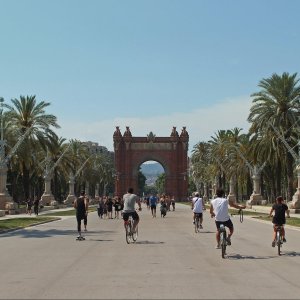
As a result of the COVID19 pandemic, we have seen an increase in stress, poor mental health and domestic violence. And we have seen an increase in the visits to green and blue spaces, leading at times to overcrowding in these spaces. In a city like Barcelona, Collserola, a large urban forest that was used to very few visitors, has now replaced the famous Las Ramblas as a place to be for walking on the weekend. Also the beach area has become a motorway of walkers and cyclists during the weekend, leading at times to conflicts between the two groups. Clearly, there is not enough green space making it difficult to keep distance.
Visiting nature as an escape is understandable. Numerous studies have shown that the presence- and visits to green spaces can reduce stress and improve restoration in the brain, and thereby improve mental health (Gascon et al 2015). Green space is essential for good physical and mental health. A recent study showed that spending at least 120 minutes a week in nature is needed for good health and wellbeing (White et al 2019)
But unfortunately in cities we see often too little green space such as parks, forest or trees by the roadside. The World Health Organisation recommends green space of at least 0.5 hectare within 300 metres of their house (WHO 2016) for everyone, but many people don’t, particularly in poorer areas.
Greening cities can have many health benefits including longer life expectancy, fewer mental health problems, improved cognitive functioning, better mood and healthier babies (Nieuwenhuijsen et al 2017). It also mitigates air pollution, heat and noise levels. It adds to CO2 sequestration and therefore helps in our fight again the climate crisis. And green space can improve ecosystems and increase biodiversity in cities, particularly through well designed green infrastructure through the city (Coutts and Hahn 2015).
A recent study showed that children who went to a school with more green spaces had considerably better cognitive functioning than those who went to a school with less green spaces (Dadvand et al 2015), while another study found that early child hood exposure to green spaces leads to fewer mental health problems in adult life (Preuß et al 2019)
Multiple studies have found that green space reduces premature mortality (Rojas-Rueda et al 2019, and increasing tree canopy from 20% to 30% in a city such as Philadelphia could prevent more than 400 premature deaths annually (Kondo et al 2020). Particularly poorer neighbourhoods would benefit.
Replacing roads and car parking with green environments, for example by planting trees, can be one way forward to change an environment from detrimental to beneficial for sustainability, liveable and health (Nieuwenhuijsen 2020). Before the COVID19 pandemic, in a city like Barcelona, 60% of public space was taken up by infrastructure for the car (Ajuntament de Barcelona 2020), and part of it could and should be replaced by green space, which helps lower the heat island effects. New urban models like the Barcelona Superblocks could increase green space and thereby improving health (Mueller et al 2020).
However, increasing green space is not always straight forward. The EU funded GoGreenRoutes project (https://gogreenroutes.eu/) is evaluating the implementation of “nature-based solutions” such as green corridors, linear parks, pocket parks and shared walkways to enhance the physical and mental health in a large number of cities, and this will strengthen the evidence base. Importantly, the project will use a co-creation to increase acceptance and effectiveness.
But it is not only green space that has many benefits, also blue spaces like rivers, lakes and the sea, as they could provide space for restoration (Gascon et al 2017).
Now more than ever there is a need for more and larger natural outdoor public spaces such as parks, forests, road trees, rivers, lakes and seas. These are great public investments, as they not only reduce the transmission risk of COVID19, but also reduce stress and provide space for respite. They are a great resource for people and society and an increased effort should be made to maintain and improve them to improve our mental health.
- Mark J Nieuwenhuijsen PhD
Research Professor in Environmental Epidemiology, Director Air pollution and Urban Environment, Director Urban planning, Environment and Health Initiative, Editor-in-Chief Environment International, President International Society for Environmental Epidemiology - ISGlobal - Barcelona Institute for Global Health - Campus MAR - Barcelona Biomedical Research Park (PRBB)
References:
Ajuntament de Barcelona 2020 https://ajuntament.barcelona.cat/superilles/es/noticia/mejoras-en-la-supermanzana-del-poblenou-gracias-a-las-aportaciones-vecinales Accessed 12/05/2020
Coutts C and Hahn M. Green Infrastructure, Ecosystem Services, and Human Health. Int. J. Environ. Res. Public Health 2015, 12, 9768-9798
Dadvand P, Nieuwenhuijsen MJ, Esnaola M, Forns J, Basagaña X, Alvarez-Pedrerol M, Rivas I, López-Vicente M, De Castro Pascual M, Su J, Jerrett M, Querol X, Sunyer J. Green spaces and cognitive development in primary schoolchildren. Proc Natl Acad Sci 2015;112(26):7937-42
Gascon M, Triguero-Mas M, Martínez D, Dadvand P, Forns J, Plasència A, Nieuwenhuijsen MJ. Mental Health Benefits of Long-Term Exposure to Residential Green and Blue Spaces: A Systematic Review. Int J Environ Res Public Health. 2015;12:4354-4379
Gascon M, Zijlema W, Vert C, White MP, Nieuwenhuijsen MJ. Outdoor blue spaces, human health and well-being: A systematic review of quantitative studies. Int J Hyg Environ Health. 2017; S1438-4639(17)30269-9.
Google 2020 https://www.google.com/covid19/mobility/ Accessed 21/05/2020
Kondo MC, Mueller N, Locke DH, Roman LA, Rojas-Rueda D, Schinasi LH, Gascon M, Nieuwenhuijsen MJ. Health impact assessment of Philadelphia's 2025 tree canopy cover goals. Lancet Planet Health. 2020 Apr;4(4):e149-e157.
Mueller N, Rojas-Rueda D, Khreis H, Cirach M, Andrés D, Ballester J, Bartoll X, Daher C, Deluca A, Echave C, Milà C, Márquez S, Palou J, Pérez K, Tonne C, Stevenson M, Rueda S, Nieuwenhuijsen M. Changing the urban design of cities for health: The superblock model. Environ Int. 2020; 134:105132
Nieuwenhuijsen MJ, Khreis H, Triguero-Mas M, Gascon M, Dadvand P. Fifty Shades of Green: Pathway to Healthy Urban Living. Epidemiology. 2017;28: 63–71
Nieuwenhuijsen MJ. Urban and transport planning pathways to carbon neutral, liveable and healthy cities; A review of the current evidence. Environ Int. 2020 Apr 6:105661.
Preuß M, Nieuwenhuijsen M, Marquez S, Cirach M, Dadvand P, Triguero-Mas M, Gidlow C, Grazuleviciene R, Kruize H, Zijlema W. Low Childhood Nature Exposure is Associated with Worse Mental Health in Adulthood. Int J Environ Res Public Health. 2019 May 22;16(10). pii: E1809.
Rojas-Rueda, D., Nieuwenhuijsen, M. J., Gascon, M., Perez-Leon, D., & Mudu, P. (2019). Green spaces and mortality: a systematic review and meta-analysis of cohort studies. The Lancet Planetary Health, 3(11), e469-e477.
White, M. P., Alcock, I., Grellier, J., Wheeler, B. W., Hartig, T., Warber, S. L., ... & Fleming, L. E. (2019). Spending at least 120 minutes a week in nature is associated with good health and wellbeing. Scientific reports, 9(1), 1-11.
WHO. (2016). Urban green spaces and health. A review of evidence. Copenhaguen. Retrieved from http://www.euro.who.int/__data/assets/pdf_file/0005/321971/Urban-green-s...

